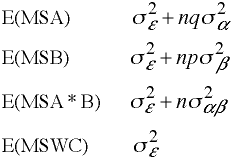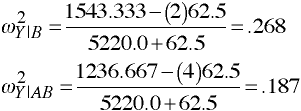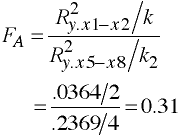The hypotheses are concerned with variances.
Random-effects Hypotheses
A Main Effect --
H0: σ2α = 0;
H1: σ2α ≠ 0
B Main Effect --
H0: σ2β = 0;
H1: σ2β ≠ 0
A*B Interaction --
H0: σ2αβ = 0;
H1: σ2αβ ≠ 0
Random-Effects Expected Mean Squares
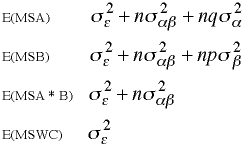
Random-effects ANOVA Summary Table
| Source | SS | df | MS | F | Error Term
|
| A Main effect | 190.000 | 2 | 95.000 | .31 | MS A*B
|
| B Main effect | 1543.333 | 2 | 771.666 | 2.50 | MS A*B
|
| A*B Interaction | 1236.667 | 4 | 309.167 | 4.95 | MS WCell
|
| Within Cells | 2250.000 | 36 | 62.500
|
| Total | 5220.000 | 44
|
Strength of Association
Partial Intraclass Correlation

Computing variance components:
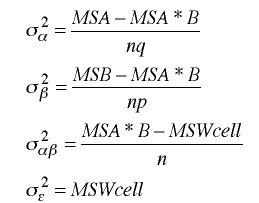
Variance components from the example above:

Partial intraclass correlations from the example above:
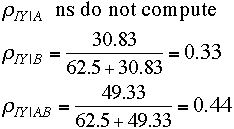
Mixed-effects Model
In a design with two independent variables there are two different mixed-effects models possible:
- A fixed & B random, or
- A random & B fixed
A fixed & B random Hypotheses
A Main Effect --
H0: αj = 0 for all j;
H1: αj ≠ 0 for some j
B Main Effect --
H0: σ2β = 0;
H1: σ2β ≠ 0
A*B Interaction --
H0: σ2αβ = 0;
H1: σ2αβ ≠ 0
A fixed & B random Expected Mean Squares
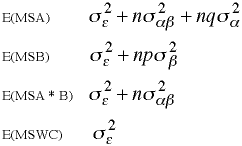
A fixed & B random ANOVA Summary Table
| Source | SS | df | MS | F | Error Term
|
| A Main effect | 190.000 | 2 | 95.000 | .31 | MS A*B
|
| B Main effect | 1543.333 | 2 | 771.666 | 12.35 | MS WCell
|
| A*B Interaction | 1236.667 | 4 | 309.167 | 4.95 | MS WCell
|
| Within Cells | 2250.000 | 36 | 62.500
|
| Total | 5220.000 | 44
|
Why does the fixed variable use interaction as the error term?
According to Hays' (2nd Ed) in a two-way design in which A (the columns) is fixed and
B (the rows) is random,
the levels of B represent a random sample from the population of possible levels.
Hays points out that the deviation of a column mean from the grand mean includes not only
column effects and mean error deviation but also includes a deviation due to interaction
effect of the cell mean from the grand cell mean (cj - Mc). The reason that this is so
is that there is no requirement that the interaction effects sum to zero across the rows
when the row treatment effects and thus the the interaction effects are only a random
sample of such effects. Thus, column means formed by summing across rows contain not
only fixed column effects but also some random interaction effects.
A random & B fixed Hypotheses
A Main Effect --
H0: σ2α = 0;
H1: σ2α ≠ 0
B Main Effect --
H0: βk = 0 for all k;
H1: βk ≠ 0 for some k
A*B Interaction --
H0: σ2αβ = 0;
H1: σ2αβ ≠ 0
A random & B fixed Expected Mean Squares
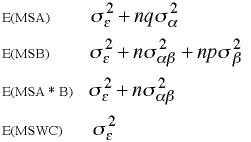
A random & B fixed ANOVA Summary Table
| Source | SS | df | MS | F | Error Term
|
| A Main effect | 190.000 | 2 | 95.000 | 1.52 | MS WCell
|
| B Main effect | 1543.333 | 2 | 771.666 | 2.50 | MS A*B
|
| A*B Interaction | 1236.667 | 4 | 309.167 | 4.95 | MS WCell
|
| Within Cells | 2250.000 | 36 | 62.500
|
| Total | 5220.000 | 44
|
Using Stata
Example problem taken from
Completely Randomized Factorial Design
use http://www.philender.com/courses/data/crf33, clear
anova y a b a#b /* fixed effects model */
Number of obs = 45 R-squared = 0.5690
Root MSE = 7.90569 Adj R-squared = 0.4732
Source | Partial SS df MS F Prob > F
-----------+----------------------------------------------------
Model | 2970 8 371.25 5.94 0.0001
|
a | 190 2 95 1.52 0.2324
b | 1543.33333 2 771.666667 12.35 0.0001
a#b | 1236.66667 4 309.166667 4.95 0.0028
|
Residual | 2250 36 62.5
-----------+----------------------------------------------------
Total | 5220 44 118.636364
anova y a b / a#b / /* random effects model */
Number of obs = 45 R-squared = 0.5690
Root MSE = 7.90569 Adj R-squared = 0.4732
Source | Partial SS df MS F Prob > F
-----------+----------------------------------------------------
Model | 2970 8 371.25 5.94 0.0001
|
a | 190 2 95 0.31 0.7514
b | 1543.33333 2 771.666667 2.50 0.1979
a#b | 1236.66667 4 309.166667
-----------+----------------------------------------------------
a#b | 1236.66667 4 309.166667 4.95 0.0028
|
Residual | 2250 36 62.5
-----------+----------------------------------------------------
Total | 5220 44 118.636364
anova y a b a#b /* mixed effects model: a fixed; b random */
Number of obs = 45 R-squared = 0.5690
Root MSE = 7.90569 Adj R-squared = 0.4732
Source | Partial SS df MS F Prob > F
-----------+----------------------------------------------------
Model | 2970 8 371.25 5.94 0.0001
|
a | 190 2 95 1.52 0.2324
b | 1543.33333 2 771.666667 12.35 0.0001
a#b | 1236.66667 4 309.166667 4.95 0.0028
|
Residual | 2250 36 62.5
-----------+----------------------------------------------------
Total | 5220 44 118.636364
test a / a#b
Source | Partial SS df MS F Prob > F
-----------+----------------------------------------------------
a | 190 2 95 0.31 0.7514
a#b | 1236.66667 4 309.166667
anova y a b a#b /* mixed effects model: b fixed; a random */
Number of obs = 45 R-squared = 0.5690
Root MSE = 7.90569 Adj R-squared = 0.4732
Source | Partial SS df MS F Prob > F
-----------+----------------------------------------------------
Model | 2970 8 371.25 5.94 0.0001
|
a | 190 2 95 1.52 0.2324
b | 1543.33333 2 771.666667 12.35 0.0001
a#b | 1236.66667 4 309.166667 4.95 0.0028
|
Residual | 2250 36 62.5
-----------+----------------------------------------------------
Total | 5220 44 118.636364
test b / a#b
Source | Partial SS df MS F Prob > F
-----------+----------------------------------------------------
b | 1543.33333 2 771.666667 2.50 0.1979
a#b | 1236.66667 4 309.166667
Using Orthogonal Coding
Example problem taken from
Completely Randomized Factorial Design
input a b y x1 x2 x3 x4
1 1 24 1 1 1 1
1 1 33 1 1 1 1
1 1 37 1 1 1 1
1 1 29 1 1 1 1
1 1 42 1 1 1 1
1 2 44 1 1 -1 1
1 2 36 1 1 -1 1
1 2 25 1 1 -1 1
1 2 27 1 1 -1 1
1 2 43 1 1 -1 1
1 3 38 1 1 0 -2
1 3 29 1 1 0 -2
1 3 28 1 1 0 -2
1 3 47 1 1 0 -2
1 3 48 1 1 0 -2
2 1 30 -1 1 1 1
2 1 21 -1 1 1 1
2 1 39 -1 1 1 1
2 1 26 -1 1 1 1
2 1 34 -1 1 1 1
2 2 35 -1 1 -1 1
2 2 40 -1 1 -1 1
2 2 27 -1 1 -1 1
2 2 31 -1 1 -1 1
2 2 22 -1 1 -1 1
2 3 26 -1 1 0 -2
2 3 27 -1 1 0 -2
2 3 36 -1 1 0 -2
2 3 46 -1 1 0 -2
2 3 45 -1 1 0 -2
3 1 21 0 -2 1 1
3 1 18 0 -2 1 1
3 1 10 0 -2 1 1
3 1 31 0 -2 1 1
3 1 20 0 -2 1 1
3 2 41 0 -2 -1 1
3 2 39 0 -2 -1 1
3 2 50 0 -2 -1 1
3 2 36 0 -2 -1 1
3 2 34 0 -2 -1 1
3 3 42 0 -2 0 -2
3 3 52 0 -2 0 -2
3 3 53 0 -2 0 -2
3 3 49 0 -2 0 -2
3 3 64 0 -2 0 -2
end
generate x5 = x1*x3
generate x6 = x1*x4
generate x7 = x2*x3
generate x8 = x2*x4
regress y x1 x2 x3 x4 x5 x6 x7 x8
Source | SS df MS Number of obs = 45
---------+------------------------------ F( 8, 36) = 5.94
Model | 2970.00 8 371.25 Prob > F = 0.0001
Residual | 2250.00 36 62.50 R-squared = 0.5690
---------+------------------------------ Adj R-squared = 0.4732
Total | 5220.00 44 118.636364 Root MSE = 7.9057
------------------------------------------------------------------------------
y | Coef. Std. Err. t P>|t| [95% Conf. Interval]
---------+--------------------------------------------------------------------
x1 | 1.5 1.443376 1.039 0.306 -1.427302 4.427302
x2 | -1.166667 .8333333 -1.400 0.170 -2.856745 .5234117
x3 | -3.833333 1.443376 -2.656 0.012 -6.760635 -.9060318
x4 | -3.5 .8333333 -4.200 0.000 -5.190078 -1.809922
x5 | -.25 1.767767 -0.141 0.888 -3.835198 3.335198
x6 | .25 1.020621 0.245 0.808 -1.819915 2.319915
x7 | 3.083333 1.020621 3.021 0.005 1.013419 5.153248
x8 | 1.916667 .5892557 3.253 0.002 .7216008 3.111733
_cons | 35 1.178511 29.698 0.000 32.60987 37.39013
------------------------------------------------------------------------------
test x1 x2 /* using residual as error */
( 1) x1 = 0.0
( 2) x2 = 0.0
F( 2, 36) = 1.52
Prob > F = 0.2324
test x3 x4 /* using residual as error */
( 1) x3 = 0.0
( 2) x4 = 0.0
F( 2, 36) = 12.35
Prob > F = 0.0001
test x5 x6 x7 x8 /* using residual as error */
( 1) x5 = 0.0
( 2) x6 = 0.0
( 3) x7 = 0.0
( 4) x8 = 0.0
F( 4, 36) = 4.95
Prob > F = 0.0028
regress y x1 x2
Source | SS df MS Number of obs = 45
---------+------------------------------ F( 2, 42) = 0.79
Model | 190.00 2 95.00 Prob > F = 0.4590
Residual | 5030.00 42 119.761905 R-squared = 0.0364
---------+------------------------------ Adj R-squared = -0.0095
Total | 5220.00 44 118.636364 Root MSE = 10.944
------------------------------------------------------------------------------
y | Coef. Std. Err. t P>|t| [95% Conf. Interval]
---------+--------------------------------------------------------------------
x1 | 1.5 1.998015 0.751 0.457 -2.532157 5.532157
x2 | -1.166667 1.153554 -1.011 0.318 -3.494634 1.1613
_cons | 35 1.631372 21.454 0.000 31.70776 38.29224
------------------------------------------------------------------------------
regress y x3 x4
Source | SS df MS Number of obs = 45
---------+------------------------------ F( 2, 42) = 8.82
Model | 1543.33333 2 771.666667 Prob > F = 0.0006
Residual | 3676.66667 42 87.5396825 R-squared = 0.2957
---------+------------------------------ Adj R-squared = 0.2621
Total | 5220.00 44 118.636364 Root MSE = 9.3563
------------------------------------------------------------------------------
y | Coef. Std. Err. t P>|t| [95% Conf. Interval]
---------+--------------------------------------------------------------------
x3 | -3.833333 1.708212 -2.244 0.030 -7.280645 -.3860213
x4 | -3.5 .9862369 -3.549 0.001 -5.490307 -1.509693
_cons | 35 1.39475 25.094 0.000 32.18528 37.81472
------------------------------------------------------------------------------
regress y x5 x6 x7 x8
Source | SS df MS Number of obs = 45
---------+------------------------------ F( 4, 40) = 3.10
Model | 1236.66667 4 309.166667 Prob > F = 0.0257
Residual | 3983.33333 40 99.5833333 R-squared = 0.2369
---------+------------------------------ Adj R-squared = 0.1606
Total | 5220.00 44 118.636364 Root MSE = 9.9791
------------------------------------------------------------------------------
y | Coef. Std. Err. t P>|t| [95% Conf. Interval]
---------+--------------------------------------------------------------------
x5 | -.25 2.231405 -0.112 0.911 -4.759837 4.259837
x6 | .25 1.288302 0.194 0.847 -2.353756 2.853756
x7 | 3.083333 1.288302 2.393 0.021 .4795777 5.687089
x8 | 1.916667 .7438015 2.577 0.014 .4133877 3.419946
_cons | 35 1.487603 23.528 0.000 31.99344 38.00656
------------------------------------------------------------------------------
Regression Results Summarized
model m0: R-square 0.5690
model m1: R-square 0.0364
model m2: R-square 0.2957
model m3: R-square 0.2369
Random-Effects F-ratios Using Regression
F-ratio for B main effect
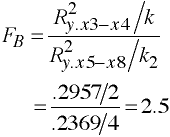
With 2 & 4 degrees of freedom
Random & Mixed Effects Using test2
The test2 command (available from ATS) can be used to perform tests with different
error terms after using regress. The test2 command is an alternative to
computing the F-ratio manually.
regress y x1 x2 x3 x4 x5 x6 x7 x8
Source | SS df MS Number of obs = 45
-------------+------------------------------ F( 8, 36) = 5.94
Model | 2970.00 8 371.25 Prob > F = 0.0001
Residual | 2250.00 36 62.50 R-squared = 0.5690
-------------+------------------------------ Adj R-squared = 0.4732
Total | 5220.00 44 118.636364 Root MSE = 7.9057
------------------------------------------------------------------------------
y | Coef. Std. Err. t P>|t| [95% Conf. Interval]
-------------+----------------------------------------------------------------
x1 | 1.5 1.443376 1.04 0.306 -1.427302 4.427302
x2 | -1.166667 .8333333 -1.40 0.170 -2.856745 .5234117
x3 | -3.833333 1.443376 -2.66 0.012 -6.760635 -.9060318
x4 | -3.5 .8333333 -4.20 0.000 -5.190078 -1.809922
x5 | -.25 1.767767 -0.14 0.888 -3.835198 3.335198
x6 | .25 1.020621 0.24 0.808 -1.819915 2.319915
x7 | 3.083333 1.020621 3.02 0.005 1.013419 5.153248
x8 | 1.916667 .5892557 3.25 0.002 .7216008 3.111733
_cons | 35 1.178511 29.70 0.000 32.60987 37.39013
------------------------------------------------------------------------------
test2 x1 x2 / x5 x6 x7 x8 /* using A*B as error */
Testing: x1 x2
Error term: x5 x6 x7 x8
F( 2, 4) = .31
Prob > F = 0.7514
test2 x3 x4 / x5 x6 x7 x8 /* using A*B as error */
Testing: x3 x4
Error term: x5 x6 x7 x8
F( 2, 4) = 2.50
Prob > F = 0.1979
test x5 x6 x7 x8 /* using residual as error */
( 1) x5 = 0.0
( 2) x6 = 0.0
( 3) x7 = 0.0
( 4) x8 = 0.0
F( 4, 36) = 4.95
Prob > F = 0.0028
Linear Statistical Models Course
Phil Ender, 24sep10, 29apr06, 12Feb98
